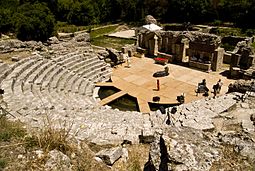Butrint
Butrint (Latin: Buthrōtum; from Ancient Greek: Βουθρωτόν and Βουθρωτός[2], romanized: Bouthrōtón) was an ancient Greek and later Roman city and bishopric in Epirus.[3][4][5] The city is considered as one of the most important archaeological sites in Albania. With its vast cultural, historical and natural value with a considerable history, Butrint became part of UNESCO World Heritage site in 1992. It became a National Park in 2000.[6][7]
| Butrint (in Albanian) Boυθρωτόν Bouthroton (in Greek) Buthrotum (in Latin) | |
 Theatre of Buthrotum | |
| Location | Vlorë County, Albania |
|---|---|
| Region | Chaonia |
| Coordinates | 39°44′44″N 20°1′14″E / 39.74556°N 20.02056°E |
| Type | Settlement |
| History | |
| Periods | Antiquity and Middle Ages |
| Site notes | |
| Archaeologists | Luigi Maria Ugolini and Hasan Ceka |
| Public access | yes |
| Criteria | Cultural: iii |
| Reference | 570 |
| Inscription | 1992 (16th Session) |
| Extensions | 1999 |
| Endangered | 1997 to 2005 |
| Official name | Butrint |
| Designated | 28 March 2003 |
| Reference no. | 1290[1] |
Buthrotum was a city of the Epirote tribe of the Chaonians. It started declining in Late Antiquity. It later became abandoned during the Middle Ages after a major earthquake flooded most of the city.
It is now an archeological site in Vlorë County, Albania. It is about 14 kilometres south of Sarandë and close to the Greek border. It is located on a hill overlooking the Vivari Channel, and is part of the Butrint National Park.
Directions
changeThe site of Butrint is accessible from Sarandë. Its road was first built in 1959 for a visit by the Soviet leader Nikita Khrushchev. The road was improved during the summer of 2010.
The construction was somewhat of an environmental disaster. It one point, it threatened Butrint's World Heritage Site status. The ancient city is becoming a popular tourist destination. It attracts day-trippers from the nearby Greek holiday island of Corfu. Hydrofoils (30 minutes) and ferries (90 minutes) run daily between the New Port in Corfu Town and Saranda.
Many visitors from Corfu use chartered coach services to visit Butrint from Sarandë. A regular public bus service runs between Sarandë port and Butrint. Others arrive from the Qafe Bote border crossing with Greece near Konispol and cross the Vivari Channel by the cable ferry at Butrint.
Gallery
changeNotable people
change- Saint Therinus, 3rd-century saint
- Donatus of Euroea, 4th-century saint
References
change- ↑ "Butrint". Ramsar Sites Information Service. Retrieved 25 April 2018.
- ↑ Stephanus of Byzantium, Ethnica, O709.1
- ↑ Borza, Eugene N. (1992). In the Shadow of Olympus: the Emergence of Macedon (Revised ed.). Princeton, New Jersey: Princeton University Press. "Speakers of these various Greek dialects settled different parts of Greece at different times during the Middle Bronze Age, with one group, the 'northwest' Greeks, developing their own dialect and peopling central Epirus. This was the origin of the Molossian or Epirotic tribes." "[...] a proper dialect of Greek, like the dialects spoken by Dorians and Molossians." "The western mountains were peopled by the Molossians (the western Greeks of Epirus)."
- ↑ Crew, P. Mack (1982). The Cambridge Ancient History – The Expansion of the Greek World, Eighth to Sixth Centuries BC, Part 3: Volume 3 (Second ed.). Cambridge, UK: Cambridge University Press. "That the Molossians... spoke Illyrian or another barbaric tongue was nowhere suggested, although Aeschylus and Pindar wrote of Molossian lands. That they in fact spoke greek was implied by Herodotus' inclusion of Molossi among the Greek colonists of Asia Minor, but became demonstrable only when D. Evangelides published two long inscriptions of the Molossian State, set up p. 369 BC at Dodona, in Greek and with Greek names, Greek patronymies and Greek tribal names such as Celaethi, Omphales, Tripolitae, Triphylae etc. As the Molossian cluster of tribes in the time of Hecataeus included the Orestae, Pelagones, Lyncestae, Tymphaei and Elimeotae, as we have argued above, we may be confindent that they too were Greek-speaking."
- ↑ Hammond, NGL (1994). Philip of Macedon. London, UK: Duckworth. "Epirus was a land of milk and animal products.... The social unit was a small tribe, consisting of several nomadic or semi-nomadic groups, and these tribes, of which more than seventy names are known, coalesced into large tribal coalitions, three in number: Thesprotians, Molossians and Chaonians.... We know from the discovery of inscriptions that these tribes were speaking the Greek language (in a West-Greek dialect)"
- ↑ UNESCO World Heritage site. "Butrint". whc.unesco.org.
- ↑ "PER SHPALLJEN PARK KOMBETAR NE MBROJTJE TE SHTETIT TE ZONES ARKEOLOGJIKE TE BUTRINTIT" (PDF). imk.gov.al (in Albanian). Archived from the original (PDF) on 2017-10-27. Retrieved 2018-02-14.
Other websites
changeGeneral information
change- Butrint National Park
- The Butrint Foundation Archived 2016-03-18 at the Wayback Machine
History articles
changeNotes
change- Ceka N., Butrint: A guide to the city and its monuments (Migjeni Books) Tirana 2005)
- Crowson A., "Butrint from the Air", in Current World Archaeology 14 (2006).
- Hansen, Inge Lyse and Richard Hodges, eds., Roman Butrint: An Assessment. Oxford: Oxbow Books, 2007.
- Hodges, R.; Bowden, W.; Lako, K. (2004), Byzantine Butrint: Excavations and Surveys 1994–99 (PDF), Oxford: Oxbow Books
- Richard Hodges and Matthew Logue, "The Mid-Byzantine Re-Birth of Butrint", Minerva 18, #3 (May/June 2007): 41–43.
- A. M. Liberati, L. Miraj, I. Pojani, F. Sear, J. Wilkes and B. Polci, ed. by O. J. Gilkes. The Theatre at Butrint. Luigi Maria Ugolini's Excavations at Butrint 1928-1932, (Albania Antica IV) (Supplementary volume no. 35. Published by the British School at Athens, 2003).
- Jarrett A. Lobell, Ages of Albania (Archeology magazine March/April 2006)
- Ugolini L. M., Butrinto il Mito D'Enea, gli Scavi. Rome: Istituto Grefico Tiberino, 1937 (reprint Tirana: Istituto Italiano di Cultura, 1999)
